The latest trading data is in, and it is evident that this quarter one region’s wines have had particular success at auction. We’ve calculated which wines have seen the greatest incremental increases in bottles traded by using figures collated by Wine Market Journal from sales at the world’s major auction houses, looking at the total number of bottles sold of the top five vintages for each wine over the past four quarters.
In contrast to last quarter’s data, which saw wines from a variety of regions see trading volumes rise, all five wines in the table below are from Bordeaux. Four are from the left bank, with first growth Haut-Brion benefitting the most from increased trade, while right bank Ausone also makes the cut.
Latour is the only wine to feature two quarters running. This presents an interesting counterpoint to the château’s reported fall in trading volumes on the wine exchange Liv-ex. Since its decision in 2012 to withdraw from the en primeur system, Latour has held back its five most recent vintages. It seems unsurprising, therefore, that the wine is less present than its fellow first growths on trading platforms, where recent vintages tend to attract high volumes of trade. However, this has not affected the wine’s success on the auction market, which favours older vintages, and therefore arguably makes for a fairer comparison.
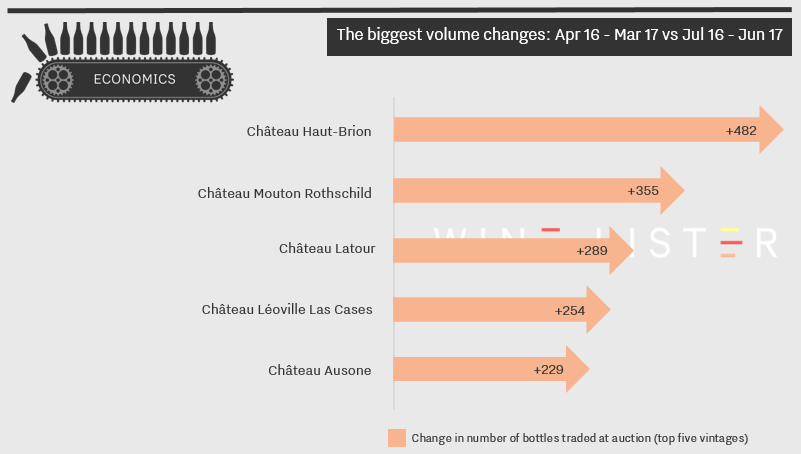
When it comes to wine scores, we’re all used to looking at quality and critic ratings. Wine Lister scores incorporate two other crucial measures: Economics and Brand. Today, we take a closer look at these categories in the context of the top Bordeaux crus in our 2017 Bordeaux Market Study.
Brand: not much in it
We begin with the Brand category, based on search frequency and distribution. The first thing to notice is that score differentials are incredibly narrow. The 15th wine in Economics terms achieves a score of 932, while the 15th wine in the Brand table gets 992 – testament to the incredible brand strength of Bordeaux crus in general.
Three wines share the top spot, with near-perfect scores of 999 apiece: Lafite, Mouton, and Yquem. Latour and Margaux have lost one point since last year, putting them in joint fourth with Haut-Brion, up one place, while Pauillac and Pomerol powerhouses, Lynch-Bages and Petrus, share seventh position. Only two right bank wines achieve Brand scores in the top 15, and Cheval Blanc is the only Saint-Emilion premier grand cru classé A to feature.
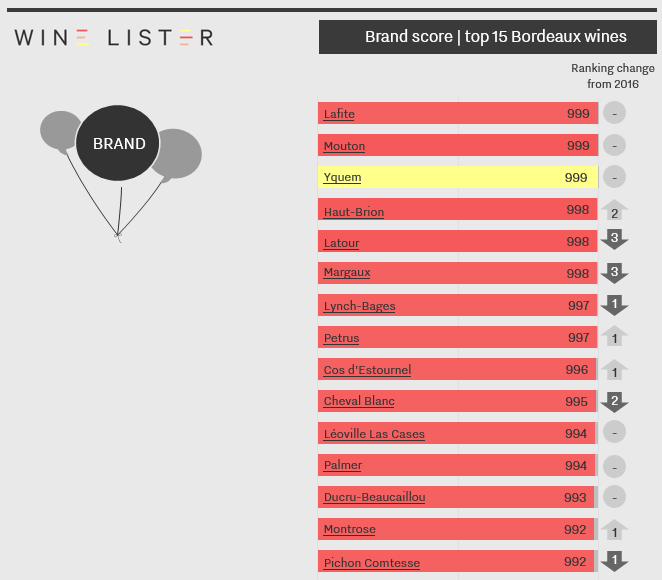
Economics: all change at the top
We now move onto the Economics score, based on a variety of price metrics and liquidity. Unsurprisingly, due to the constantly changing nature of its component parts, the Economics category displays significant changes over a 12-month period. The order of wines in the top 15 has completely changed from the previous year. Compared with the Brand table, the top 15 is also very different: wines have moved in and out, and the order has shifted.
In a continued display of commercial strength, Angélus has moved up three places into pole position, while second and third places are also occupied by right bank wines: Pomerol’s Le Pin and Petrus. The first growths have all moved up the table since last year, in part thanks to improved price performance, although Latour still trails the others. The wine that has most improved on 2016 – a new entrant into the top 15 – is Ausone, up 26 places, while Beychevelle has also seen significant improvement. Pavillon Rouge is the only second wine in the top 15.
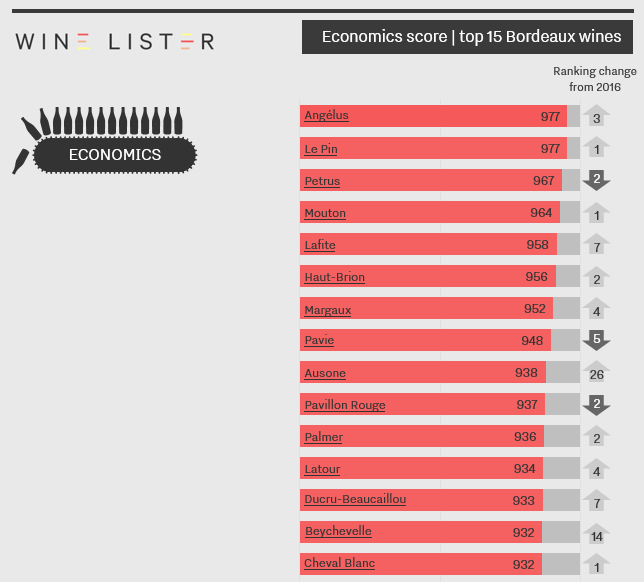
For the top Bordeaux crus in terms of overall Wine Lister score – which takes into account a wine’s Quality score as well as those for Economics and Brand – take a look here.
These are excerpts from Wine Lister’s 48-page Bordeaux Market Study – subscribers can download the full report from the Analysis page.
Trading volumes are a key measure of a wine’s success in the marketplace. To evaluate these, Wine Lister uses figures collated by Wine Market Journal from sales at the world’s major auction houses, looking at the total number of bottles sold of the top five vintages traded for each wine over the past four quarters.
With the first quarter data now in, we look at which wines saw the greatest incremental increase in bottles traded. Although the list is dominated by French wines, top of the table is a Tuscan, Biondi Santi Brunello di Montalcino Riserva. The producer was recently highlighted as one to watch in a survey of Wine Lister’s Founding Members. The rise in auction sales for this wine has had a significant impact on its Economics score, boosting it from 911 to 945/1000. Volume is just one of the five criteria that feed into a wine’s Economics score, along with four different price-related metrics.
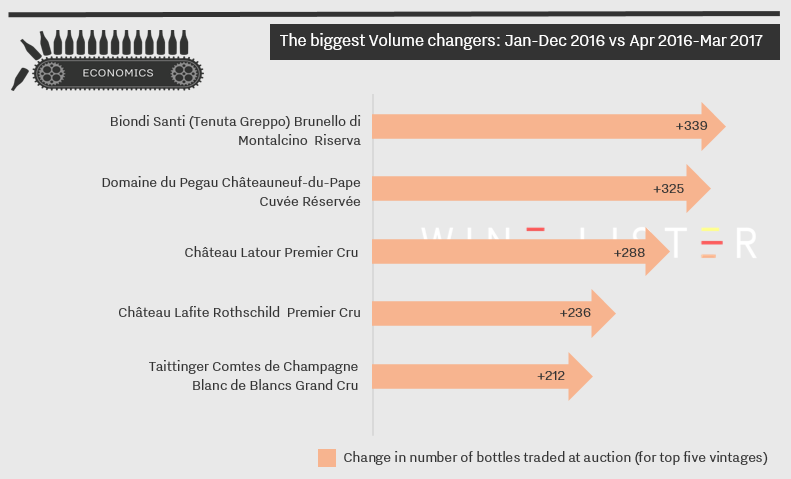
The wine seeing the second largest gain in trading volumes, Domaine du Pegau Châteauneuf-du-Pape Cuvée Réservée, also has the lowest Economics score of the table, at 789. Nonetheless, its overall Wine Lister score is very strong at 846 (lifted by a high score for Brand), and with the latest data in from Wine Market Journal its Economics score is on the rise.
The final three wines of the table – two Bordeaux first growths and a prestigious Champagne (Taittinger Comtes de Champagne) – also benefitted from increased trades in the last quarter. All three enjoy very high Economics scores, with Lafite Rothschild the highest, at 955/1000. Meanwhile it seems that 2017 has been a positive year so far for Latour, which was also among the top five wines that saw its number of searches increase significantly in March.
Trading volumes are a key measure of a wine’s success in the marketplace. To evaluate these, Wine Lister uses figures collated by Wine Market Journal from sales at the world’s major auction houses, looking at the total number of bottles sold of the top five vintages traded for each wine over the past four quarters.
A change in trading volumes impacts a wine’s Economics score. The chart below pulls out the biggest gainers in the last quarter of 2016, comparing auction data from the 12 months leading up to the end of Q3 2016 to data for the calendar year.
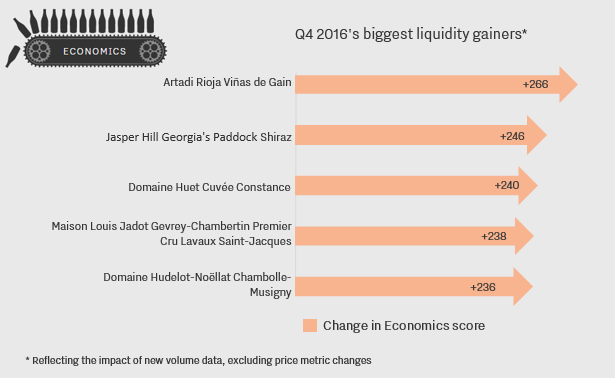
Wines from a variety of regions saw their Economics scores boosted by auction sales in the final quarter of 2016, suggesting a healthy broadening of interest in addition to the usual suspects.
Gaining most was Artadi Rioja Viñas de Gain, which saw trading volumes from January-December 2016 increase tenfold. Its Economics score remains relatively low, at 420/1000.
Australia and the Loire also made an appearance. Domaine Huet Cuvée Constance enjoys a very strong Economics score of 796/1000, and also excels in terms of Quality and Brand, leaving it with a very strong overall Wine Lister rating of 856/1000.
Burgundy is still on the rise at auction, and was the only region to feature twice, with Maison Louis Jadot Gevrey-Chambertin Premier Cru Lavaux Saint-Jacques and Domaine Hudelot-Noëllat Chambolle-Musigny.




